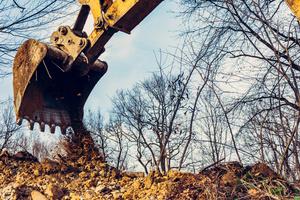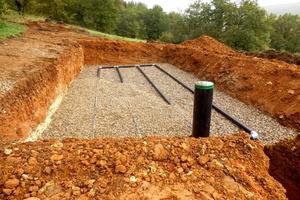If your swimming pool is not getting as much use as you’d like or maintaining it has become a burden, you may be considering demolishing it. Removing an unwanted swimming pool can leave you with a large area in your yard that can be used for many other purposes, such as gardening, relaxing or playing. However, it is important to fill in the space correctly to ensure the integrity of the yard.
Here is a look at how various layers of fill and dirt are typically used following a pool removal.
Filling in Your Pool

First, it is important to distinguish between a pool fill-in and a full pool removal. If you are considering layering dirt in the pool cavity yourself, it is likely a pool fill-in. With a pool fill-in, also known as a partial removal, the pool is drained, holes are punched in the bottom, and the top few feet of the pool are demolished. The rubble that results is then placed in the bottom of the pool before filling it with more dirt and topsoil and compacting everything. This is a faster and more affordable method of removing a pool, but it must be disclosed to future buyers if you sell the home. It also prevents you from building in the area in the future.
A fill-in is not the same as a full pool removal. A full removal is a more thorough process that must be carried out by professionals. It involves breaking down the entire pool shell and hauling it away before filling in the area and compacting it thoroughly. This requires heavy equipment and experienced operators, and many municipalities also require the services of a soil engineer to ensure the area is stable. However, this is the only option for those who wish to build on the space where the pool stood previously, and it is also the recommended approach for those who wish to sell their home as they will not need to disclose to potential buyers that there was once a pool on the property.
Layering Dirt in a Partial Pool Removal
Before you can layer dirt in your pool, you need to drain it completely, manually pushing the last of the water down the drain if necessary. You’ll also need to dismantle pool accessories such as the pump, lights, and ladders.
Then, the top 18 to 36 inches of the pool shell should be broken down. Be sure to call in a professional for this step if you lack the proper equipment and experience. Then, a jackhammer must be used to create holes in the bottom of the pool cavity. This step is essential for stopping moisture from collecting at the bottom of the pool. Experts advise placing one hole roughly every four feet. Once these steps are completed, you can begin to fill the cavity in.
Gravel Layer

The first layer will typically be made up of gravel, and experts advise filling the pool up to the halfway point using this material. Because gravel is very heavy, many homeowners opt to have it dumped directly into the pool cavity by truck.
Gravel is the material of choice for this first layer because it allows water to travel through it to the drain at the bottom, preventing backups and flooding in the yard. It does not absorb water, and it settles immediately once it has been poured. This layer should be compacted before moving onto the next layer.
Clean Fill For Sand
The next layer in a partial pool removal is made up of clean fill or sand. This layer is placed directly on top of the gravel and should stop around two feet below the top of the swimming pool. It is important to compact this layer fully before applying the next one.
Topsoil
The top layer is made up of actual dirt, and topsoil is the preferred material for this layer. It should be placed in the pool from the top of the clean fill (or sand layer) to the top of the pool cavity. Topsoil is chosen because it enables grass and vegetation to grow across the pool area to even out the yard and create a more natural appearance. This will help to ensure that there is not an obvious patch or change in vegetation and elevation in the yard to indicate where the pool previously stood. Other types of dirt are not appropriate for this layer.
This layer should be placed a few inches higher than the lawn’s existing grade to allow some margin for it to settle over time. Otherwise, you could experience a low spot in your lawn in the future. You should also compact the topsoil after it has been placed.
Why Is Compaction So Important?
You may have noticed that each layer of dirt needs to be compacted. Why is this so important?

Failing to properly compact the soil may cause it to settle over time, and this can put everything in the yard in jeopardy. Not only can it create unsightly sinkholes, but it could lead to flooding issues that could damage patios, decks or furniture and ruin your garden. Pool demolition contractors used tools like trench rollers and vibratory soil compactors in order to achieve an appropriate density.
Before embarking on any pool fill-in project, it is important to find out about any local regulations that apply to removing swimming pools. For example, you may be required to obtain a permit before carrying out the work or have an inspection carried out by a soil engineer. In addition, your municipality might require that you use specific materials for filling in the pool or place layers of a certain thickness. There may also be regulations that relate to compaction levels. This aspect of pool removal can be complicated, but if you work with a pool removal company, they will ensure that all of the local regulations are followed.
Adding Trees or Plants
Depending on your intended use of the space, you might consider adding trees or plants to the area to help hold the soil in place. If this spot starts to sink, you may need to add more topsoil to it in the future.
Get in Touch With the Northern Virginia Pool Demolition Team
Ensure your pool demolition project is successful by hiring professionals to carry out the work. At Dirt Connections, our trained and experienced pool demolition team can perform a full or partial pool removal safely and efficiently, haul away the demolished material, deliver fill dirt, and thoroughly compact the site. Contact us today to learn more about our services.
Summary

Dirt Connections was started with one goal in mind: providing quality residential and commercial construction services to clients on time and on budget. Reach out for more information on how we can support your next project.
For your convenience our estimates are free and by appointment. Call 703-940-9949 for a free estimate today!










































